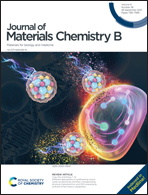Aminopeptidase N-targeting nanomolecule-assisted delivery of VEGF siRNA to potentiate antitumour therapy by suppressing tumour revascularization and enhancing radiation response†
Abstract
Tumour revascularization and the consequent radioresistance activated by the up-regulated angiogenic pathway after radiation exposure remain a major bottleneck for improving the tumouricidal effect of radiotherapy (RT) in hepatocellular carcinoma (HCC). Herein, we show that fabricated aminopeptidase N (ANP/CD13)-targeting Gd-hybridized gold nanomolecules (tGd–GNMs) can efficaciously suppress tumour revascularization and the consequent radioresistance, and then synergize in augmenting the RT response. Both in vitro and in vivo experiments demonstrate that the targeted delivery of vascular endothelial growth factor (VEGF) siRNA into the tumour site and the generation of an abundance of intratumourally cytotoxic reactive oxygen species (ROS) under X-ray radiation by the tGd–GNMssiRNA complex has the capability to down-regulate VEGF gene expression and strengthen the radiation response. Furthermore, the tGd–GNMssiRNA complex contributes to excellent active tumour targeting ability, remarkably enhancing tumour contrast in the fluorescence, computed tomography (CT) and magnetic resonance (MR) imaging modalities in real-time with a long imaging time window. Overall, the synthesized tGd–GNMssiRNA complex with excellent potentiation of the antitumour ability and real-time multimodal imaging ability represents a promising visualized theranostic nanoplatform for the treatment of HCC.



 Please wait while we load your content...
Please wait while we load your content...